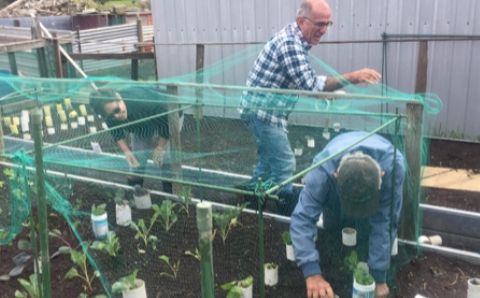
09 Dec Maara kai with koro
Our Kaiārahi | Nutrition, Sande Mareroa-Gates, spent some time with her green thumbed dad talking about māra kai from yesteryears and now. Read on to hear what he had to say.
I wish I could have painted the wonderful expression on my 84 year old Dad’s face when I asked him if he could share his māra kai practices with you – I’d be the owner of a priceless portrait.
“What? Why do they want to know how I grow veggies, I’m not as good as the old folks…
I remember when I was a boy in the Bay, Harataunga, now those were gardens. Heck, those were the days. We’d have Māmā and Pāpā talking about where so and so was getting the pikopiko (fern fronds) and which area was being harvested too much so we would put a rāhui on it. Well, not a rāhui like you fellas do it these days, just a time to rest, yeah, just resting the ngāhere.
Anyway, all the whānau would plant together, we’d all fish together, some would hunt, but we’d all share and celebrate together.
I suppose I don’t think about planting by the moon because maramataka is a way of life. You don’t even think about when the best time to plant is or when the best time to fish is, you just know. You know? We just knew. Whiro, Tirea, all you need to do is look at the moon and you know which one it is. Tamatea, Otane, Tangaroa Amua, you know those ones??
Dad’s talking to me like it’s common knowledge. I nod respectfully.
“Who had the best gardens, Dad?”
“It didn’t matter who had the best garden- we shared it. We were one big Pa – a community. There were a couple of whānau who didn’t have green fingers but they still got their share and preserves, Māmā made sure of that. Oh, she could cook. I can still see her face smiling at us.”
“Come on, Dad, who had the best garden?” I persist.
“Ha ha, you’re not gonna get me to tell you so you can tell everyone. A man would be wrong to say that and a stupid fella would let you print it!”
A heavy edit was required here due to the colourful kupu my father was using.
“Kōkihi (NZ spinach) isn’t the same as it used to be,” he continues. “It was much sweeter then. It used to grow freely about now in October/November. You’d see it start to grow and then we would pick it late in December/January in time for the Christian Christmas and New Years.
Sometimes we would pick the seedlings (to transplant) and grow it in the garden if we didn’t have any close by, but usually we’d just go and get it where it was plentiful. Then we’d let her (Papatuanuku) rest and Tawhirimatea and Tumatauenga would do what they had to do, you know, they help to spread the seeds so that they can grow again.”
“So what are you planting in your garden, what have you got in your garden now, Dad?” I ask.
“Oh, just what you fellas like to eat. Now’s good for beans, peas, carrots, radish, beetroot and spinach. I’ve got my marigolds and nasturtiums and the moko has some sunflower seeds so I’ll put them in to plant with my veggies.”
“Why do you put the flowers in the garden?”
“They (flowers) help to keep the bugs and pests busy and they bring the bees in. (Bees are essential to pollinate the vege plants). I’m not going to do a big one this year but I think you fellas like it so I’ll make one for you. Should be a full moon about 10-14 November, I can’t remember, but about then so I’ll plant my kumara and potato and the comfrey to help them along their way.”
My whanau know who my father is, this is wonderful kōrero for you. Respectfully, for all other readers, Dad would like to remain just my “Dad”.
Companion growing:
This is when you grow plants that help each other grow better for example you would grow carrots and tomatoes together or close to each other and basil grown in between your tomato plants are really good companions as well.
Tomatoes and potatoes don’t grow well together they can be affected by blight which is why you would isolate them. In my father’s garden potatoes, kumara and comfrey are grown completely isolated from his other veggies.



